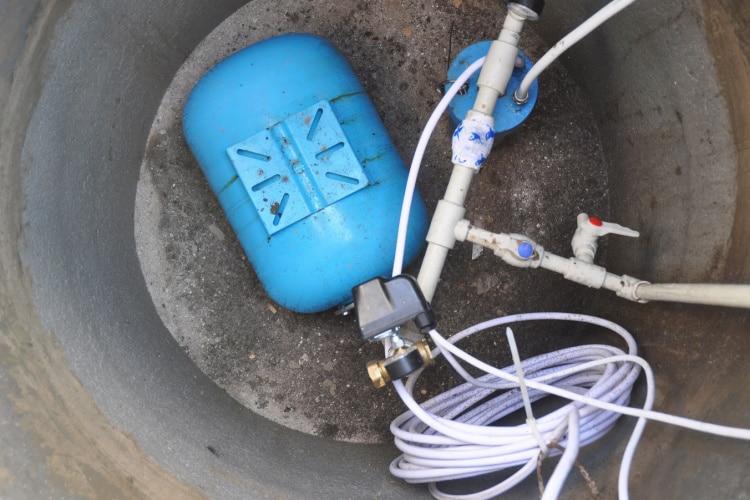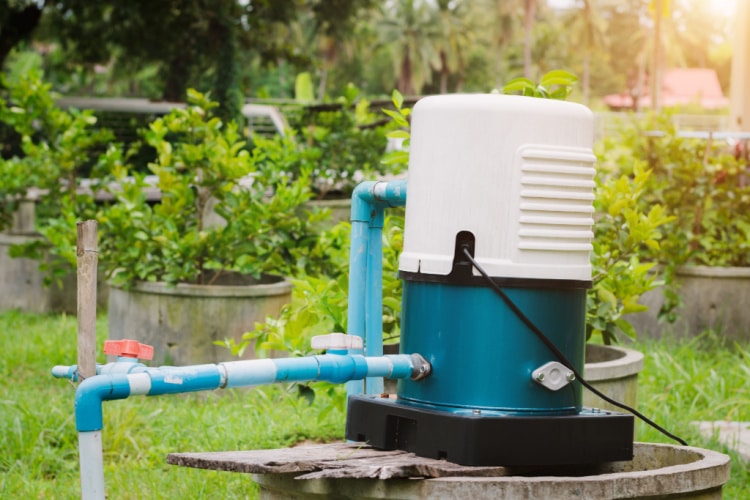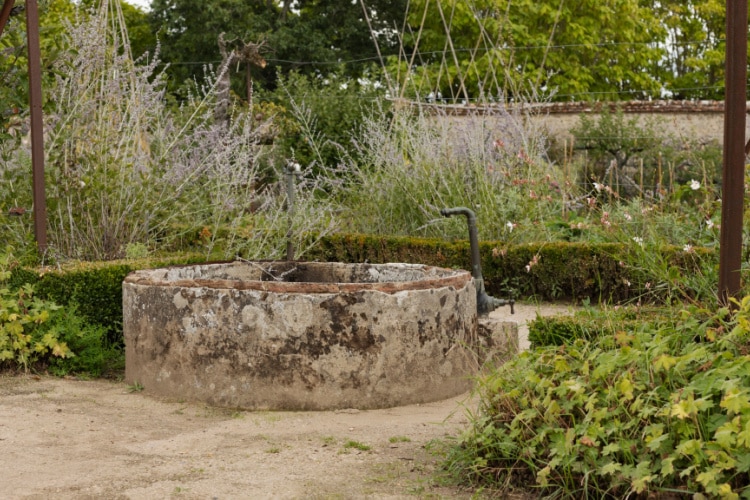Having sand in your well water isn’t something to take lightly, but before you find a fix, ensure that what you’re looking at is indeed sand by sending a sample of your well water for testing. Yes, you’ll have to pay for the service, but it will save you money and time spent on misdiagnosing the situation.
Sand in well water is very dangerous and can cause a well pump to fail or even disrupt the water flow by clogging the pipes. Once you confirm that there is indeed sand in the well, you can then start looking into the potential causes of this problem.
Here are the most common reasons for sand in well water:
- Well pump is too low
- The well screen is degraded
- Well pump pressure is too high
- Old well shaft
- A hole in the drop pipe
Tabular view with solution:
| Sand in well water cause | Solution |
|---|---|
| Well pump is too low | Ensure your well pump is 10 to 20 ft above the bottom of the well |
| Degraded well screen casing | Install a new casing |
| Well pump pressure too high | Adjust pump pressure or get a new pump for your well |
| Old well shaft | Get a new well shaft or dig a deeper well |
| A hole in the drop pipe | Inspect and replace the drop pipe |
1. Well Pump Is Too Low
If sand suddenly appears in your water despite the well pump working as it should, it could be a sign that the pump has fallen too low in the well and is now scraping the bottom.

A well pump should be set at about 10 to 20 ft from the bottom of the well. Anything lower than this would eventually pump sand into the water as time goes by.
How to fix low well water pump:
The solution here is simple; ensure your well pump is 10 – 20 ft above the bottom of the well.
2. The Well Screen Casing is Degraded
A degraded well screen can leak sand and sediment from groundwater into the well. But why does it degrade? A well screen degrades overtime due to corrosion or wear and tear.
During the drilling process, the well screen is lined with PVC, iron, and steel to form a casing that prevents sediments from entering the well. The well casing has grooves that allows groundwater flow into the well but keeps sand and sediments at bay. Over time, the screen can wear away and corrode or degrade. This makes it possible for silt and sand to enter your well.
How to fix damaged well screen:
If your well casing is damaged beyond reasonable repair, then you’ll need to install a new casing. Installing new casing is a time consuming process to undergo by yourself, so it’s best to hire a professional. They should be able to install a new screen while maintaining the well structure.
The process of installing a new casing is multi-faceted. It starts with the screen design, then the soil is drilled to add a screen centralizer. Centralizers are usually made from PVC casing or flexible wood. Once they’re in place, the screen installation is then done by gluing the PVC.
The cost of installing a new well screen ranges from $6 per foot of PVC to over $120 per foot if you want to go the stainless steel route. From here, it all depends on the surface of the casing, as well as the depth of the well and the soil that surrounds it. The final cost can be anywhere from $300 to $3000.
That being said, some well casings are so old or have such a narrow diameter that it’s just not feasible to add to what’s already there. In this case, the only solution would be to replace your well entirely.
3. Well Pump Pressure is too High
If your well pump has too much horsepower, then it’s likely sucking in more than it should – pulling soil and sand into the water. This is not only bad for the water quality, but it can eventually damage the pump. The constant flow of sand at such high power level affects the pump’s valves and causes even more sand build-up inside the well.

How to fix high pressure pump:
The easy fix is to reduce the pump’s pressure, or if that’s not an option, get a less powerful pump that will be a better fit for your well.
There are a slew of different pumps on the market to get if you eventually decide to change the pump to one that suits your needs. Prices range from $300–$500 for a standard pump and can cost as much as $4,000 for the more high-end well pumps.
4. Old Well Shaft
Both shallow and old wells should be water tested a lot more frequently than new ones. In the case of old wells that have old shafts, the water should be tested every season. This is because bad weather like wind, heavy storm, or snow, increases the chances of dirt and debris entering the well.

If you have an old well shaft and notice a drastic change in water quality, then you should immediately test the water for coliform bacteria and nitrate, as well as testing for debris and sediments.
How to fix old well shaft with sand debris:
Unfortunately getting a new well shaft is the only viable solution. You can try to place a case around the shaft and isolate it that way, but a good casting will probably cost you as much as replacing the whole shaft. A good shaft will cost you about $7,500. The final price mainly depends on the type and diameter of your well.
5. A Hole in the Drop Pipe
A leak in the well’s drop pipe will cause irregular water pressure. This is because the pump will automatically start and turn off by itself very frequently. This can lead to substantial sediment and sand pull on every restart. The sand that is being pulled into your water system every few minutes puts a great strain on the pump and the pressure tank.
How to fix leaky drop pipe:
The solution here is to pull the pipe out of the well and inspect the drop pipe. Unfortunately, not all well installations have this as an option. We recommend that you don’t do this unless you know exactly what you’re doing. You could end up causing more damage to the drop pipe, in which case you might need to get a completely new one, which can be costly.
A new one-inch drop pipe will cost you anywhere from $135 to $400 per 100 feet.
Additional Tips for Dealing With Sand in your Well Water
Now that we’ve discussed the 5 most common culprits behind sand in your well water, here are some additional tips to foolproof your well water system.
Always Reach Out to a Professional When in Doubt
The best course of action if you’re not expert or haven’t positively identified the exact cause of the problem is to get professional help.
Professionals have tools that you may not have at your disposal, such as well cameras that go down the well to inspect the entirety of your well’s screen on their way down.
Consider Installing a Centrifugal Sand Separator
You should consider installing a centrifugal sand separator in-between the pressure tank and the well to filter sand and sediment before it enters the home. Centrifugal separator is a machine that uses centrifugal, gravitational and inertial forces to divide two or more substances. It has an efficiency rate of up to 98% on all mesh particles.
For wells, centrifugal separator works by pulling large particles in water into a separator. Gravity then separates the solid particles from liquids, making it possible for water to rise above sand and other solid particles.
When the separator chamber gets filled with sand, you’ll have to drain it by loosening the ball valve usually located at the bottom of the separator. This can be done both manually or automatically, depending on whether your system has an auto-flushing valve.
Consider Using a Spin-down Filter
If you don’t want to invest in a full-fledged centrifugal sand separator, installing a spin-down filter is another alternative to consider.
Spin-down filter traps and separates large chunks of sand and debris in water, similar to how a centrifugal sand separator works. However, it may not be the best option if there’s a lot of sand in your water, not because it doesn’t work, but because it requires constant cleaning/maintenance.
Another caveat is that using spin filters usually results in water pressure drop.
Conclusion
One thing to always remember when dealing with sand in your well is to first identify the source of the problem. Don’t rush into solutions without first understanding the cause, since every situation is different and warrants different approaches. The wrong decision might cost you a fortune to reverse and cause you a lot of headaches.
I found it important to know that we must hire a professional if we find sand in our well water since we don’t have the right tools for the job. Recently, my aunt moved to the countryside to a home that has a water well, and when I visited her, I noticed that her water tasted weird. I think my aunt needs to read your article about finding sand in a water well and what to do next, so I’ll email it right now.
Thank you for pointing out that sand in well water can clog pipes, cause a water well pump to malfunction, and be quite hazardous. My grandfather claimed that the sand got into the water well pump. I’ll locate a water well pump repair company so that his pump system can be fixed.
For years I lived where we only had well water. Their was never a problem with sand. Then I moved to Florida and our well water has too much sand. It causes continual problems with the appliances as the sand clogged up critical operations. This is extremely frustrating and expensive. i appreciate your advice.
Hi Linda, thank you for reading and I’m glad the content was useful.